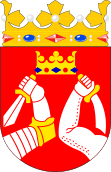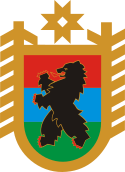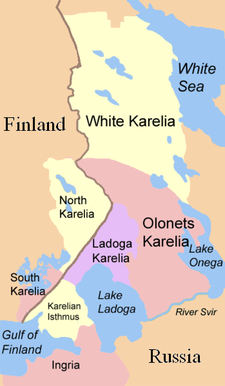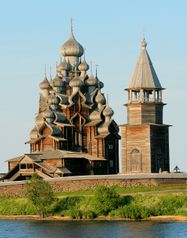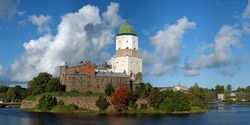كارليا
كارليا (الكارلية، والفنلندية والإستونية: Karjala؛ روسية: Карелия, Kareliya؛ سويدية: Karelen؛ إنگليزية: Karelia)، أرض شعب كارليا، هي منطقة في شمال أوروپا ذات أهمية تاريخية لكل من فنلندا وروسيا والسويد. وحالياً هي مقسمة بين جمهورية كارليا الروسية، واوبلاست لنينگراد الروسي، وفنلندا (مناطق كارليا الجنوبية وكارليا الشمالية).
استخدام الاسم
Various subdivisions may be called Karelia. كارليا الفنلندية was a historical province of Finland, and is now divided between Finland and Russia, often called just Karjala in Finnish. The eastern part of this chiefly Lutheran area was ceded to Russia after the Winter War of 1939–40. This area is the "Karelia" of the Karelian question in Finnish politics.
جمهورية كارليا هي كيان اتحادي روسي، يضم ما يسمى "كارليا الشرقية" ومعظم سكانها يدينون بالأرثوذكسية الروسية.
وضمن فنلندا الحالية، فإن Karjala تشير إلى مناطق كارليا الجنوبية والشمالية, although parts of historical Karelia also lies within the region of Kymenlaakso (Miehikkälä وVirolahti, شمال ساڤونيا (Kaavi, Rautavaara وSäyneinen) و جنوب ساڤونيا (Mäntyharju).
الجغرافيا
تمتد كارليا من ساحل البحر الأبيض إلى خليج فنلندا. وتضم أكبر بحيرتين في أوروپا، بحيرة لادوگا و بحيرة اونيگا. ويقع البرزخ الكاريلي بين خليج فنلندا وبحيرة لادوگا.
The border between Karelia and Ingria, the land of the closely related Ingrian people, had originally been the Neva river itself but later on it was moved northward into Karelian isthmus to follow the Sestra River (روسية: Сестра), today in the Saint Petersburg metropolitan area, but in 1812–1940 the Russo-Finnish border.
Tver Karelia denotes the villages in the Tver Oblast that are inhabited by Tver Karelians.

التجمعات السكنية
- جمهورية كارليا
- پيتروزاڤودسك (Петрозаводск, پيتروسكوي Petroskoi، من أواخر 1941 وحتى 1944 كانت تُعرف بإسم Äänislinna/Onegaborg للفنلنديين)
- Belomorsk (Беломорск, Sorokka)
- Medvezhyegorsk (Медвежьегорск, Karhumäki)
- Kalevala (Калевала, Uhtua)
- Kem (Кемь, Vienan Kemi, compare with Kemi)
- Kostomuksha (Костомукша, Kostamus)
- Kondopoga (Кондопога, Kontupohja)
- Sortavala (Сортавала, Sortavala, Sordavala)
- Segezha (Сегежа, Sekehe)
- Pitkyaranta (Питкяранта, Pitkäranta)
- Olonets (Олонец, Aunus)
- البرزخ الكاريلي
- كارليا الجنوبية
- إيماترا
- Joutseno
- Lappeenranta (Villmanstrand)
- كارليا الشمالية
التاريخ
Karelia was bitterly fought over by the Swedes and the Novgorod Republic for a period starting in the 13th-century Swedish-Novgorodian Wars. The Treaty of Nöteborg (Finnish: Pähkinäsaaren rauha) in 1323 divided Karelia between the two. Viborg (Finnish: Viipuri) became the capital of the new Swedish province. In the Treaty of Stolbovo in 1617 large parts of Russian Karelia were ceded to Sweden. Conflicts between the new Swedish rulers and the indigenous population of these areas led to an exodus: thousands of Karelians, including the ancestors of the Tver Karelians, emigrated to Russia.
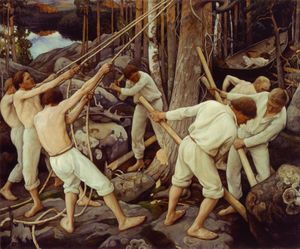
The Treaty of Nystad (Finnish: Uudenkaupungin rauha) in 1721 between Imperial Russia and Sweden ceded most of Karelia to Russia. After Finland had been occupied by Russia in the Finnish War, parts of the ceded provinces (Old Finland) were incorporated into the Grand Duchy of Finland. In 1917, Finland became independent and the border was confirmed by the Treaty of Tartu in 1920.
السياسة
Karelia is divided between Finland and Russia. The Republic of Karelia is a federal subject of Russia, which was formed in 1991 from the Karelian ASSR. The Karelian Isthmus belongs to the Leningrad Oblast. The Finnish side consists of parts of the regions (maakunta) of South Karelia, North Karelia and Kymenlaakso.
There are some small but enthusiastic groups of Finns campaigning for closer ties between Finland and Karelia. The political expression of these irredentist hopes is called the Karelian question and is about Finland's re-acquisition of the ceded Finnish Karelia. These hopes live on, for instance, in the Karjalan Liitto and ProKarelia. However, ambitions for closer ties with East Karelia do not include territorial demands.
الديمغرافيا
The Karelian language is spoken in the Republic of Karelia and also in the Tver Karelian villages. The Veps language is spoken on both sides of the River Svir. The so-called Karelian dialects of Finnish language which are spoken mainly in Finnish South Karelia form the southeastern dialect group of Finnish. Similar dialects are also spoken in Ingria, which is an area between the Estonian border and Lake Ladoga. They appeared there in the 17th century after the Swedish conquest of the area. The older inhabitants of the Ingria, the Ingrians, have their own language which is related to the Karelian language and the south-eastern dialects of Finnish.[1] The dialects in Finnish North Karelia belong to the large group of Savonian dialects in Eastern and Central Finland. [1] Karelians who evacuated from Finnish Karelia resettled all over Finland and today there are approximately one million people in Finland having their roots in the area ceded to the Soviet Union after the World War II. In Finland, about 5,000 people speak Karelian.
الثقافة
|
|
انظر أيضاً
- Karelia Suite, a collection of pieces by the composer Jean Sibelius.
- Asbestos-Ceramic, a type of pottery made in Karelia and vicinity.
- Karelianism, a cultural movement in the Grand Duchy of Finland.
- Mastodon (band), who pay homage to Karelia on their album Crack the Skye with the song Ghost of Karelia.
- Viipurin Lauluveikot, a Finnish men's choir founded 1897 in Vyborg, Finnish Karelia.
- "The Karelian Isthmus" is the debut album of Finnish metal band Amorphis, released in 1993.
- Lauri Törni, born in Viipuri, Törni was a soldier and winner of the Mannerheim Cross during the Continuation War, who later served with the German and American armies.
الهامش
ملاحظات
ببليوگرافيا
- "They Took My Father," by Mayme Sevander and Laurie Hertzel, a history of Finnish Americans who emigrated to Soviet Karelia during the Great Depression.
وصلات خارجية
- Karelians (The Peoples of the Red Book)
- Tracing Finland's eastern border - ThisisFINLAND
- Saimaa Canal links two Karelia -ThisisFINLAND
- Regional flag
- Visitkarelia.fi - Information about travel, tourism and other fields in North Karelia
- Information about Southern Karelia travel
- Pielis.ru - travel information about North Karelia region and City of Joensuu
- Karelia will return in your dreams Article about Karelia with photos and useful tourist information.
- Genocide in Soviet Karelia: Stalin's Terror and the Finns of Soviet Karelia
- Pages using gadget WikiMiniAtlas
- Coordinates on Wikidata
- Articles containing روسية-language text
- Pages using Lang-xx templates
- Articles containing سويدية-language text
- Articles containing إنگليزية-language text
- Articles with hatnote templates targeting a nonexistent page
- كارليا
- بحر بارنتس
- البحر الأبيض
- جغرافيا فنلندا
- مناطق مقسمة


